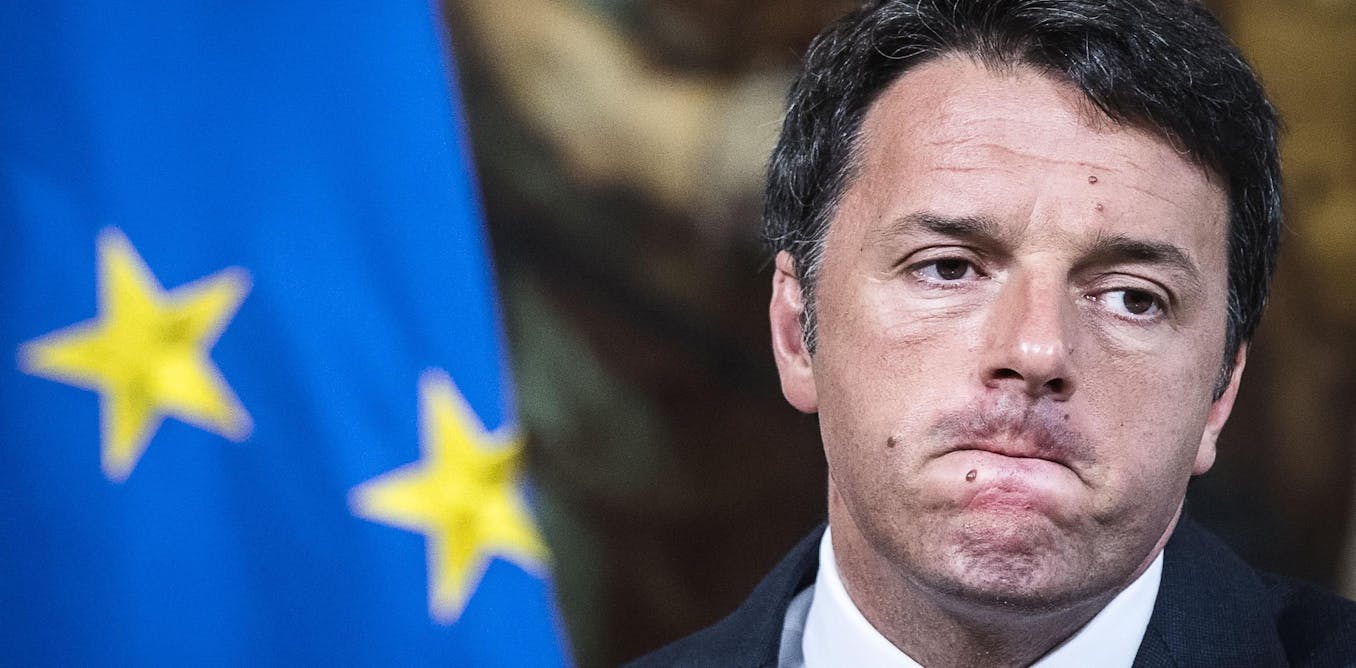
Italy’s ‘no’ vote lights another fire under the european union
- Select a language for the TTS:
- UK English Female
- UK English Male
- US English Female
- US English Male
- Australian Female
- Australian Male
- Language selected: (auto detect) - EN
Play all audios:

How to interpret the outcome of the Italian referendum? Matteo Renzi’s government is clearly the loser – and the prime minister announced his widely expected resignation as soon as the
result was in. The proposed constitutional reform would have given much more power to Renzi by taking it away from the Italian Senate. It was part of a wider package of political reforms
pushed by his government which can be summed up as the idea that Italy needed to be “unlocked”. The constitutional changes were presented as consolidating this new trajectory, together with
a new electoral law designed to underpin the reformed constitution. The referendum confirmed that 59.1% of voters had other ideas. Renzi’s government was initially wildly popular but lost
support as it became clearer over nearly three years in power that the material conditions of large sections of the population were not progressing but stagnating or, in some cases, getting
worse. Constitutional matters in Italy have traditionally been kept separate from ordinary politics, but not on this occasion. Because the government drafted and submitted the reform
proposals rather than the parliament, and Renzi said that he would resign if he lost, it became a vote on the government’s policies – and of course its leader. WINNERS AND LOSERS For weeks,
the prospect of a defeat for the government has been framed as another reaction against the establishment – hardly surprising in the context of Trump, Brexit and other populist movements
toppling centrists around the world. Such a reading might be supported by a quick look at some of the components behind the No campaign. The Northern League and Beppe Grillo’s Five Star
Movement represent two rather different types of right-wing politics that are prone to frame their messages in a populist way – albeit Five Star is the only one that fully fits the
anti-establishment archetype seen in other countries. Yet while the government was clearly the political subject behind the proposed constitutional reform, there was no overarching narrative
behind the No campaign. It was an aggregation of different political and social actors, from mainstream right-wing parties to trade unions and civil society associations. They did not form
a coalition or attempt to coordinate their efforts, and for obvious reasons they represented very different parts of society. Revealingly, no new movement, political subject or leader
emerged out of the contest. You also need to look at the distribution of the vote. As in other countries, we can probably point to a disenfranchised group – though it’s less about class in
Italy. We don’t have definitive data on how age affected the voting, but surveys ahead of the vote indicated that the over 65s were the only group backing Yes; while support for No was
strongest among the under 35s. Given that youth unemployment in Italy is dramatically high and the material conditions of younger people are deteriorating, the clear message is that Renzi’s
reform package was not seen as addressing this group’s problems. On the other hand, it is interesting to note that the division between centre and periphery, urban and rural areas, which
played a major role both in Brexit and in the election of Trump, does not explain what has happened in Italy. On the contrary, the No vote seems to have prevailed almost everywhere except in
the regions of Tuscany and Emilia Romagna, the historic strongholds of Renzi’s Democratic Party. In many ways, then, this was a traditional rejection of an unpopular government. ITALY AND
THE EU The most likely immediate scenario following Renzi’s resignation is that a new government will be formed, led by the Democratic Party under a new leader. It will presumably approve
the new electoral law and enact some of the bills behind Renzi’s political programme, and could in theory hold power until the current parliamentary term ends in February 2018. It might well
be that this new government will make anti-EU feeling even stronger. The likes of the Five Star Movement have understood how to capitalise on the growing tendency in this previously
pro-European country to blame the EU for austerity and society’s ills. Of course, their chances of winning the next general election depends on how the next government reforms the electoral
laws: ironically, the changes that Renzi was proposing would have favoured the Five Star Movement. No one, at this stage, can predict what the next electoral reform will look like. From this
vantage point, however, there is certainly a good chance that Italy is heading for a similar protectionist shift of the kind that looks likely to happen in the US next year. Some financial
analysts are already seeing the vote as the first step towards an Italian departure from the eurozone. So while it is too simple to say that events in Italy exactly fit those in other
countries, the outcome might well end up comparable. As if the EU did not have enough to worry about with Brexit, Le Pen, Wilders and so on, this is one more crisis that it really could do
without.
